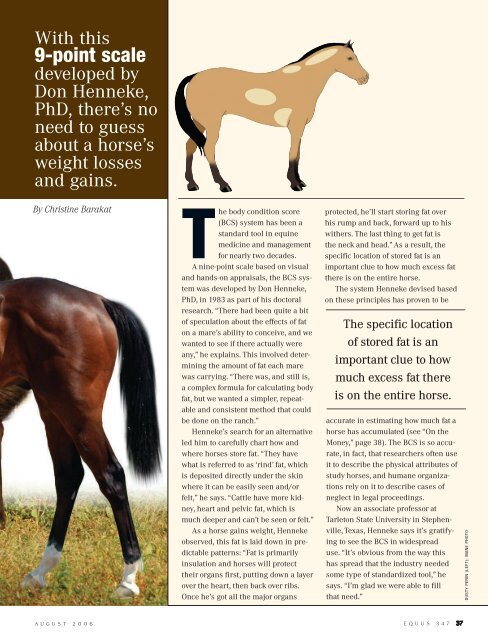Create successful ePaper yourself
Turn your PDF publications into a flip-book with our unique Google optimized e-Paper software.
With this<br />
9-point scale<br />
developed by<br />
Don Henneke,<br />
PhD, there’s no<br />
need to guess<br />
about a horse’s<br />
weight losses<br />
and gains.<br />
By Christine Barakat<br />
The body condition score<br />
(BCS) system has been a<br />
standard tool in equine<br />
medicine and management<br />
for nearly two decades.<br />
A nine-point scale based on visual<br />
and hands-on appraisals, the BCS system<br />
was developed by Don Henneke,<br />
PhD, in 1983 as part of his doctoral<br />
research. “There had been quite a bit<br />
of speculation about the effects of fat<br />
on a mare’s ability to conceive, and we<br />
wanted to see if there actually were<br />
any,” he explains. This involved determining<br />
the amount of fat each mare<br />
was carrying. “There was, and still is,<br />
a complex formula for calculating body<br />
fat, but we wanted a simpler, repeatable<br />
and consistent method that could<br />
be done on the ranch.”<br />
Henneke’s search for an alternative<br />
led him to carefully chart how and<br />
where horses store fat. “They have<br />
what is referred to as ‘rind’ fat, which<br />
is deposited directly under the skin<br />
where it can be easily seen and/or<br />
felt,” he says. “Cattle have more kidney,<br />
heart and pelvic fat, which is<br />
much deeper and can’t be seen or felt.”<br />
As a horse gains weight, Henneke<br />
observed, this fat is laid down in predictable<br />
patterns: “Fat is primarily<br />
insulation and horses will protect<br />
their organs first, putting down a layer<br />
over the heart, then back over ribs.<br />
Once he’s got all the major organs<br />
protected, he’ll start storing fat over<br />
his rump and back, forward up to his<br />
withers. The last thing to get fat is<br />
the neck and head.”As a result, the<br />
specific location of stored fat is an<br />
important clue to how much excess fat<br />
there is on the entire horse.<br />
The system Henneke devised based<br />
on these principles has proven to be<br />
The specific location<br />
of stored fat is an<br />
important clue to how<br />
much excess fat there<br />
is on the entire horse.<br />
accurate in estimating how much fat a<br />
horse has accumulated (see “On the<br />
Money,” page 38). The BCS is so accurate,<br />
in fact, that researchers often use<br />
it to describe the physical attributes of<br />
study horses, and humane organizations<br />
rely on it to describe cases of<br />
neglect in legal proceedings.<br />
Now an associate professor at<br />
Tarleton State University in Stephenville,<br />
Texas, Henneke says it’s gratifying<br />
to see the BCS in widespread<br />
use. “It’s obvious from the way this<br />
has spread that the industry needed<br />
some type of standardized tool,” he<br />
says. “I’m glad we were able to fill<br />
that need.”<br />
DUSTY PERIN (LEFT); MANE PHOTO<br />
a u g u s t 2 0 0 6<br />
E Q U U S 3 4 7 37


